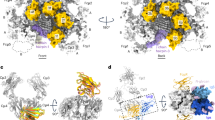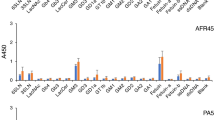Abstract
RECENT studies have suggested that membrane receptors for the Fc region of IgG (Fc receptors) may be heterogeneous structures with distinctive binding properties1–5. Walker has reported that a single cell line may possess separate Fc receptors for IgG molecules of different subclass1, and Heusser et al. have demonstrated that macrophage-like cell lines may possess two distinct receptors: one which binds monomeric IgG2a, and another which binds to aggregates of all subclasses2. Unkeless recently reported that a variant clone of the P388D1 mouse macrophage line had the same number of binding sites for IgG2a as the parent line, but only 10% of the binding sites for rabbit IgG in the form of soluble antigen–antibody complexes, suggesting the presence of two distinct Fc receptors3. The molecular identity of Fc receptors remains uncertain since few structural studies defining these membrane components are currently available6–8. In this study we demonstrate that several glycoproteins with Fc binding activity can be isolated from the plasma membranes of L1210 cells, and provide structural evidence that separate receptors may be responsible for binding IgG which has been complexed with antigen, and monomeric or aggregated IgG.
This is a preview of subscription content, access via your institution
Access options
Subscribe to this journal
Receive 51 print issues and online access
$199.00 per year
only $3.90 per issue
Buy this article
- Purchase on Springer Link
- Instant access to full article PDF
Prices may be subject to local taxes which are calculated during checkout
Similar content being viewed by others
References
Walker, W. S. J. Immun. 116, 911–914 (1976).
Heusser, C. H., Anderson, C. L. & Grey, H. M. J. exp. Med. 145, 1316–1327 (1977).
Unkeless, J. C. J. exp. Med. 145, 931–945 (1977).
Frøland, S. S., Natvig, J. B. & Michaelsen, T. E. Scand. J. Immun. 3, 375–380 (1974).
Lobo, P. I. & Horwitz, D. A. J. Immun. 117, 939–943 (1976).
Cooper, S. M. & Sambray, Y. J. Immun. 117, 511–517 (1976).
Rask, L., Klareskog, L., Ostberg, L. & Peterson, P. A. Nature, 257, 231–233 (1975).
Anderson, L. H. M. J. Immun. 118, 819–825 (1977).
Hourani, B. T., Chace, N. H., and Pincus, J. H. Biochem. biophys. Acta 328 520–532 (1973).
Marchesi, V. T. & Andrews, E. P. Science 174, 1247–1248 (1971).
Hunter, W. M., Greenwood, R. C., & Glover, J. S. Biochem. J. 89, 114–124 (1963).
Stanworth, D. R. & Turner, M. W. in Handbook of Experimental Immunology, second edition (ed. Weir, D. M.) 10.1–10.97 (Blackwell Scientific, Oxford, 1973).
Laemmli, U. K. Nature 227, 680–685 (1970).
Benya, P. D., Padilla, S. R. & Nimni, M. E. Biochemistry 16, 865–872 (1977).
Cooper, S. M. & Sambray, Y. J. supramolec. Struct. (in press).
Author information
Authors and Affiliations
Rights and permissions
About this article
Cite this article
COOPER, S., SAMBRAY, Y. & FRIOU, G. Isolation of separate Fc receptors for IgG complexed to antigen and native IgG from a murine leukaemia. Nature 270, 253–255 (1977). https://doi.org/10.1038/270253a0
Received:
Accepted:
Issue Date:
DOI: https://doi.org/10.1038/270253a0
This article is cited by
-
Molecular weight analysis of Fc?-binding proteins of lymphoid leukemia, myeloid leukemia, and hairy-cell leukemia
Journal of Cancer Research and Clinical Oncology (1981)
Comments
By submitting a comment you agree to abide by our Terms and Community Guidelines. If you find something abusive or that does not comply with our terms or guidelines please flag it as inappropriate.



